A movie made for the drive-in market, written, produced, and directed by Leonard Katzmann who has a lot to explain. The IMDB score is 3.8/10. With that in mind…. Some 1960s role modelling kills any nostalgia for those days.
In the distant future year 2000 the Space Probe Taurus is launched, though the probe is called Hope One. The crew members say repeatedly that their destination is Tyrus. Watch and listen but Taurus never puts in an appearance. That slip is characteristic of the standard of this waste of celluloid.
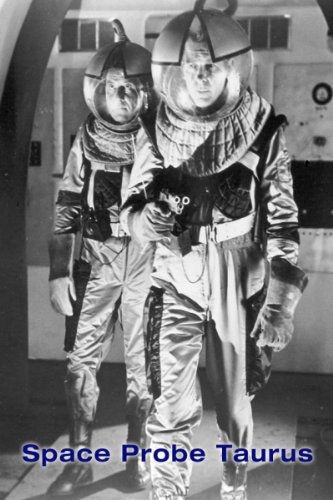 Notice the gat in hand. Wanna shake? Ready to shoot.
Notice the gat in hand. Wanna shake? Ready to shoot.
The crew of four strap into the La-Z-Boy recliners and blast off beyond the solar system. Note: beyond the solar system. Got it? Good, on that more in a moment.
There in deep space they come upon another space ship drifting by. They hail it but no one is picking up the phone. OK, they suit up, and the suits look pretty good (credit the wardrobe department) and float over where they force the door, saying it was not locked. Ah huh, burglars aways say that. Then they enter the engine room and start checking the instruments. Whoops! An alien appears in a rubber suit to protect those delicate instruments. After some mutual staring, the rubber alien refuses the handshake the unwelcome and intruding Hope captain offers, who then promptly shoots the alien with the .45 he was packing into deep space. Bam! So much for first contact. Shake or else!
Wait! It gets worse. They decide to blow up the alien ship. Whatever for? To hide the body of their victim? No, but because gravity will pull it to Earth where it will crash and hurt someone. This from beyond the solar system, remember? Deep space, get it?
Are there any more aliens on board? Are there other alien crew out and about in their rubber suits yet to return to the ship. No one knows. No one checks. No one cares. Boom!
The Probe is called the United States Probe. Not Earth probe, but United States Probe. It fits US foreign policy, bam and boom.
There is more to come. Through no fault of their own they do land on a habitable planet, where they promptly kill the first inhabitant they meet. Consistent anyway. Thereafter they congratulate themselves on finding a habitable world. It will be habitable as soon as all the indigenous inhabitants are murdered. Think Australia. Hence the ‘nullius’ in the alternative title above.
There is no irony in any of these events. Not hint of it. The acting is leaden. The story, well, what story. The special effects are rubber. Could be I am making it sound better than it is. This’ll cork it: Roger Corman made better movies! Thought I would never say that of anything.
The crew of four includes a woman, much to the annoyance of the captain who wants chaps. Bet no one expected that! But she got the job because she is a light weight. Literally. She weighs less than a male scientist. Is this clever or what? (Or what.) The two younger crew men hit on her and she finally relents. The rejected suitor, sacrifices himself to extricate the ship from another blunder. Role modelling, indeed. THE END. Amen.
In the second to last scene we learn that the probe is a desperate effort to find a place to relocate the population of the Earth or is it the United States, for reasons not theretofore mentioned or further explained though i suspected it was the aftermath of a GOP majority. Maybe as the end neared someone thought to justify the mayhem earlier in the film. Hmm. Not likely. Probably filmed that last scene first, a common practice, and then just forgot about it. Something I have tried to do myself.
No one ever watched the last feature at a drive-in, anyway. Wisdom in that, as well as hormones.
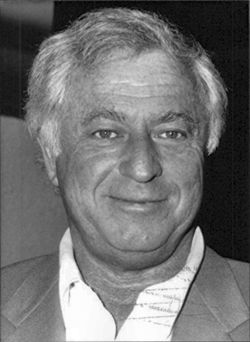 Leonard Katzmann much later.
Leonard Katzmann much later.
Thirty years later Katzmann directed more than sixty episodes of ‘Dallas.’ Atonement in that punishing duty?
Category: Film Review
‘The Atomic Man’ (1955)
It has also been released as ‘Timeslip,’ which reveals the plot. It is a low budget science fiction film.
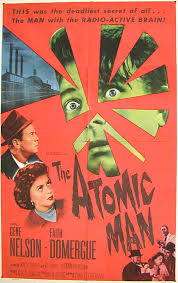
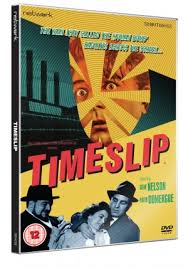
The acting is fine and the direction is crisp in the film noir manner of the era. (It was cheaper to film in low light and so many B movies were noir primarily for this financial reason.) The story is another matter. The science is silly. The villains do their best with underwritten parts. For a thriller there is a lack of urgency.
It was a ’quota quickie’ and that explains its schizophrenia about whether it is American or British. All the cast are British except for the two leads, Gene Nelson and Faith Domergue, but all speak of dollars, not pounds. Newspaper reporter Nelson fastens onto the mystery man pulled from the river who bears an uncanny resemblance to a nuclear scientist splitting atoms at a top top secret installation down the road. Connect the dots.
The secret work is no secret to Nelson who barges in and around with insufferable audacity that only works in movies. Ditto he has no trouble getting into the hospital ward guarded by the police where the victim is lying in a stupor.
Nelson and Domergue are a good team, she being a newspaper photographer.
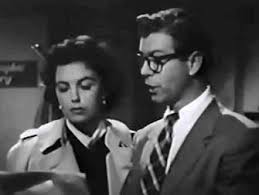 The team at work.
The team at work.
He is the action man and she does the thinking. Sporting a noir trench coat, she figures out the problem and takes several initiatives, unlike the female lead in many films of the era. But she is also stereotypical enough to wait in the car while Nelson does man-stuff, i.e., yelling at people. Don’t blame him, he did not write it.
More interesting than anything in the movie is the public policy of the ‘quota quickie’ in post war Great Britain. Westminster legislated that 25% of all cinema screenings be British made. This was not in the interest of stimulating the British film industry which at the time was working at full capacity. No. The purpose was to reduce the importation of American films by crowding them out of the theatres so that the earrings of imported films would not taken out of the country. Subtle, huh? There was no prohibition on American films, but a squeeze on cinema proprietors to discourage showing them.
However, because the British film industry was already at capacity, many studios subcontracted the films needed to meet that 25% quota to all comers, like the legendary Danziger brothers (who could knock of the unforgettable ‘Devil Girl from Mars’ in ten days), and to American shell companies set up in London in response to this opportunity. These American companies in turn put a few American touches in the films so that they could be shown in the States in the bottom half of a program or a drive-in triple feature. (Those were the days.) The touches might be leads like Nelson and Domergue, references to dollars, or mid-Atlantic accents from Brits.
This practice of subcontracting undermined the purpose of the policy yet complied with it and yet all the same channeled the money into American companies, actors, and writers.
Nelson started as a dancer but three years in the army in World War II ended the dancing days. In movies he played opposite Debbie Reynolds, Doris Day, and Virginia Mayo early in his career but as their stars ascended his did not. Who knows why. In this film he is energetic, times his lines exactly, and knows where to look, as they say behind the camera. Television offered him a second bite of the apple and there he turned to directing and made quite a career of that.
Domergue, once a protege of Howard Hughes, played a scientist in a number of B sci-fi pics like ‘This Island Earth’ (1955), which is a keeper. There is pathos here because plastic surgery figures heavily in the plot of ‘The Atomic Man’ and she herself had extensive plastic surgery as a young woman when a car crash sent her through a windscreen.
The story is by Charles Eric Maine, who also did the screen play; he was a science fiction writer with little interest in and no knowledge of science. It shows.
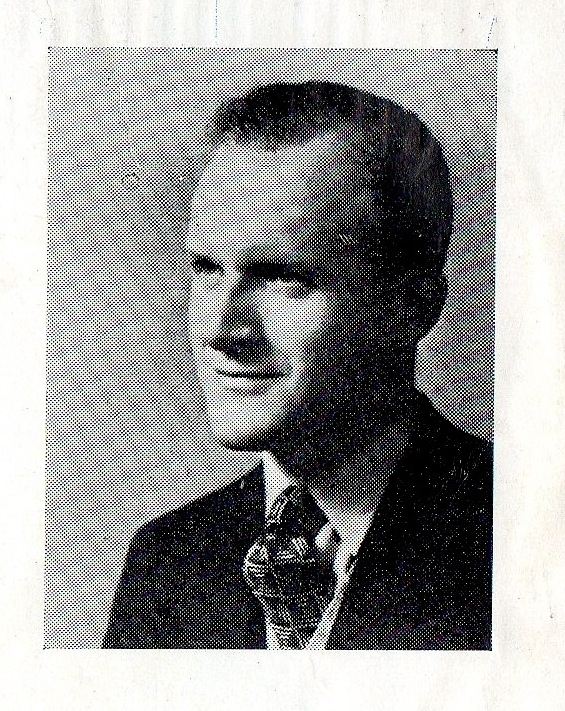
He was really a detective writer who used science fiction conventions to set up his stories, and viewed against those expectations this film is worth more than the 5.4 rating on the IMDB. This film is not science fiction. The action turns around a nuclear research laboratory and that is it. He has a long list of titles ascribed to science fiction.
‘Starship Invasions’ (1977)
For those who thought ‘Battle Beyond the Stars’ (1980) was rock bottom, try this offering.
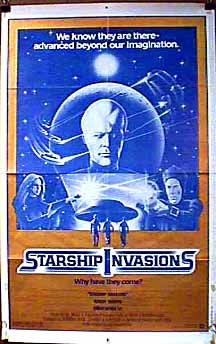
Leading the cast are Christopher Lee and Robert Vaughn. Quality right? Wrong!
The acting is Easter Island stone faces. Lips not moving. Not moving?
The aliens are telepathic; ergo their lips are sealed. Most of the film shows expressionless actors staring at each other with a voiceover for the dialogue. Exciting stuff, not. This has to be the dumbest production decision ever made, well, apart from casting Tom Cruise in anything. Christopher Lee as the chief villain imitates a department store window mannequin in a black onesie with a hood over wires on his head to make him look even stranger than usual. That works. He looks constipated.
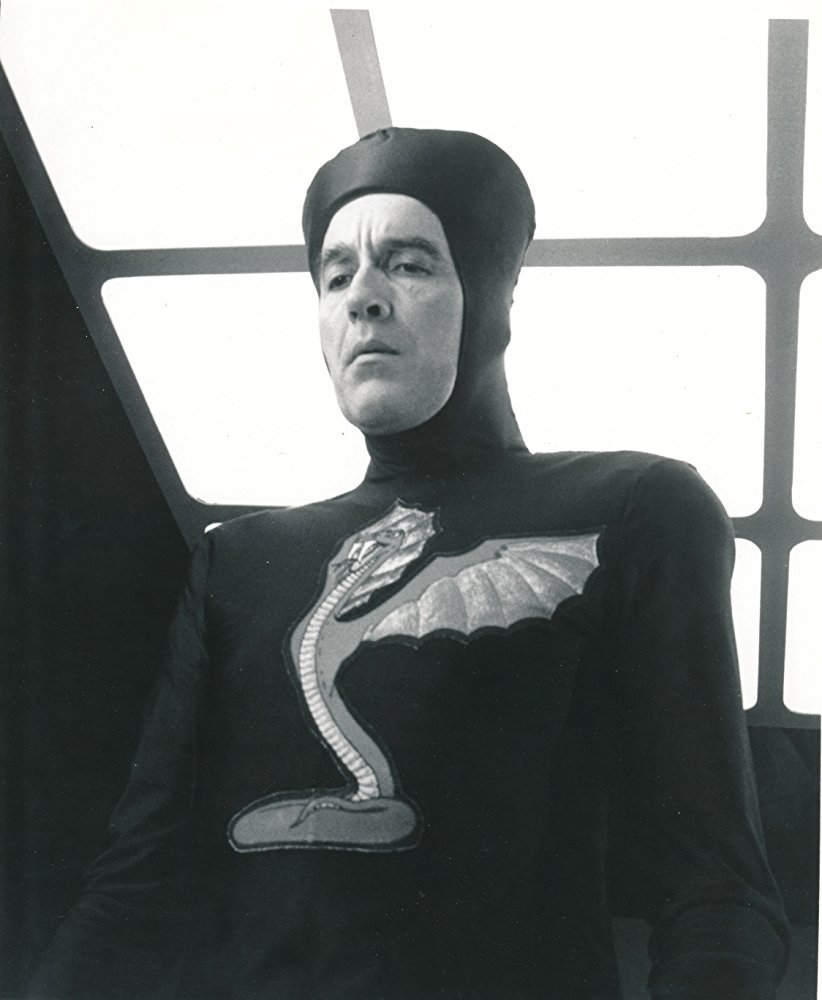 Here is Christopher Lee lips sealed ordering the destruction of the human population of Earth. Ho hum.
Here is Christopher Lee lips sealed ordering the destruction of the human population of Earth. Ho hum.
Even in the midst of a CGI spaceship battle the extras move like mannequins. An alien commander yells to his only underling, ‘Quick, shields up!’ The underling moves like he is underwater to the console, only to discover it has been sabotaged. That is quick? By the way, was this minion the one who failed to do the pre-flight check? After corporate downsizing, the alien is reduced to one underling. No backup.
Vaughn as a UFO scientist has a few lines which he manfully utters, but mostly the aliens read his thoughts. (I could read them, too, namely ‘Get me out of here! I am going to fire my agent!’) The UFOs whiz around, crash onto highways, are sighted by crowds of airforce personnel in a flyover, land in front the Toronto telephone exchange to steal some vital — as if! — computer equipment (1970s telephone routers, evidently picking up a few things for ET to use in calling home), and crash into the tower of the Bank of Montreal (which relocated to the safety of Toronto when the PQ won an election, and now this), while the authorities and media use alternative facts to deny the existence of UFOs. Faux News strikes again. That part is credible.
The one interesting idea in the screenplay is mentioned and then dropped. Early in the going Christopher Lee examines human DNA and concludes that his own race is the offspring of ancient Earthlings. Huh? How did that happen? But Lee puts aside such girly question and…villain that he is, does not hesitate for a moment to order the planetary extermination of his forbears. That intriguing idea was never mentioned again. It is treated in an episode of ‘Captain Future’ (1948) with far more energy and wit.
The Internet Movie Data Base offers a plot summary, which I do not have the will to do so myself. Yes there is a plot of sorts. The rating there of 4.0 seems high, though, as always, some liked it. That 4 is an average; some of the scorers gave it an 8 or so to balance my 1. (A ‘0’ cannot be cast. i know; I’ve tried.) Think about that. The only explanation of this celluloid muddle is the tax credits the Ontario government once offered foreign film companies when it laboured under the delusion it was going to create Onty-wood on the Mississauga. This cheap production was subsidised by Ontario taxpayers. Hence some of the supporting actors, like Vaughn’s screen wife, speak with the Ottawa Valley accent.
‘Battle Beyond the Stars’ (1980)
Another overblown and undercooked science fiction film with a sizeable budget is this entry: ‘Battle Beyond the Stars’ (1980), a CGI vehicle for John-Boy Walton, and little else.
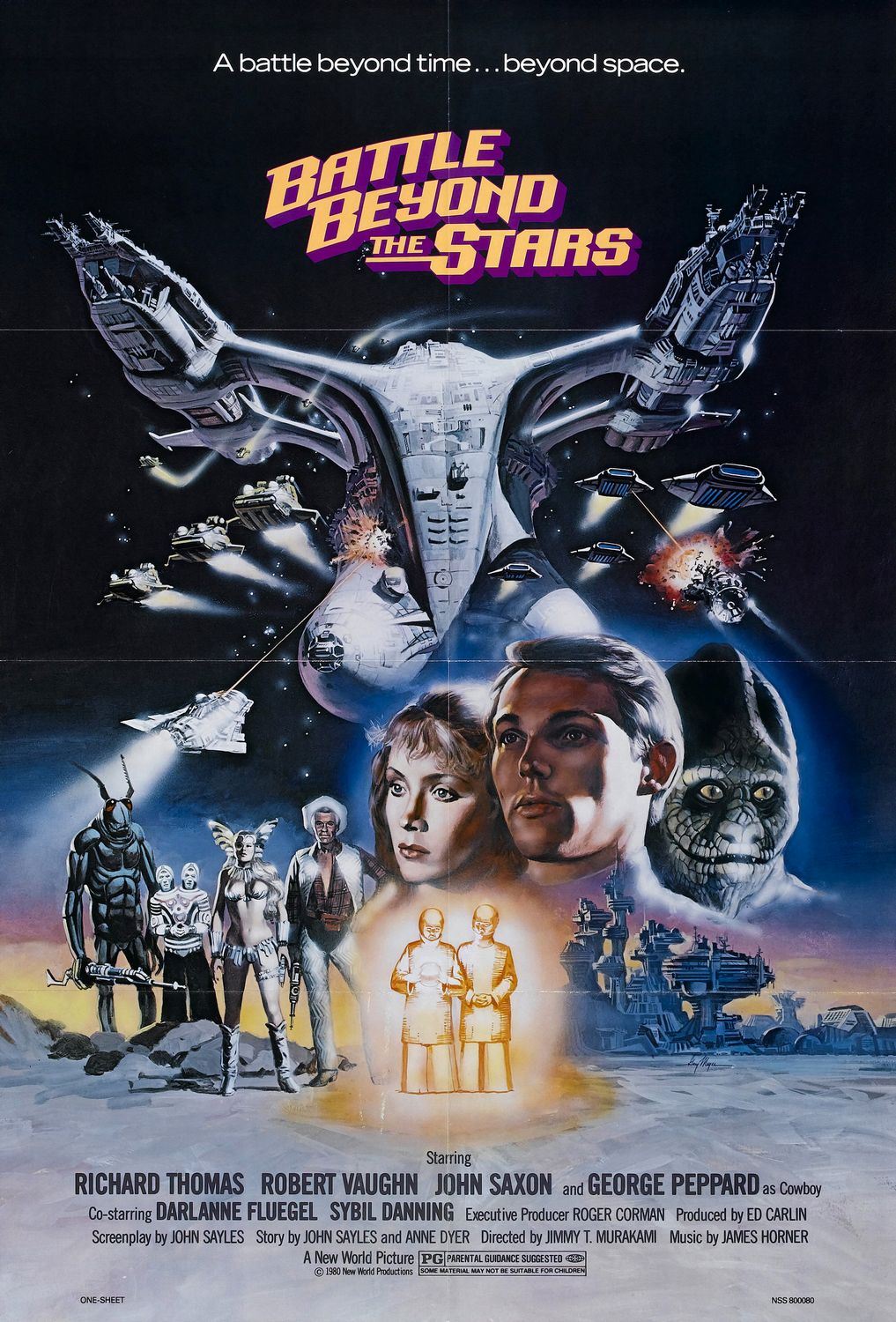
The set-up is intriguing and there are some imaginative elements along with some major talents in supporting roles, but it is decidedly underdone. It transposes ‘The Seven Samurai’ (1954) directed by Akira Kurosawa to outer space via ‘The Magnificent Seven’ directed by John Sturges (1960). Though not credited the word on the web sites is that Roget Corman directed ‘Battle Beyond the Stars.’ That alone would explain why it is so lifeless, listless, and down right lazy. Kurosawa and Sturges could direct a script from the telephone book and make it interesting, not so Corman who could make ‘The Fall of House of Usher boring.’ Not could, did.
The imaginative element was mostly in the creature-features, always a speciality of Corman. There are several but the one that caught my eye was the multiple Nestor who got the only zinger in the dialogue — ‘We always carry a spare.’ In the context it gives chuckle. And the spare comes in handy. (There is pun there for the cognoscenti.)
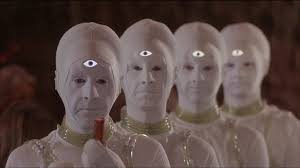 Nestor(s)
Nestor(s)
And Nestor got the only really science fiction element in this shoot ‘em space western with the moving arm. But two moments in 1hr and 44m is too little.
The major talents are Robert Vaughn and John Saxon, both of whom play their parts with deadly earnestness, and George Peppard, who quite obviously wanted to be elsewhere, and should have been. Vaughn reprises his role from the 1960 ‘The Magnificent Seven’ as a world weary, no, galaxy weary, phaser-slinger, though what his particular talents are as a murderer for hire receive no explanation, nor is there any character development apart from his clenched jaw, and ennui filled sighs.
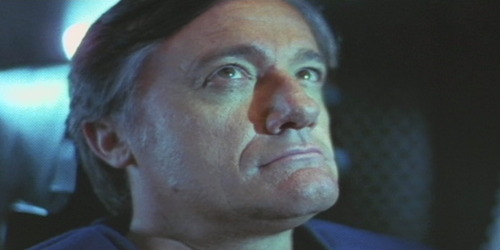 Vaughn and jaw.
Vaughn and jaw.
In contrast, John Saxon is a wonderful one-armed galactic villain! He is steely and focussed enough to burn through steel, as if this role were his chance at the stardom that eluded Carmine Orrico.
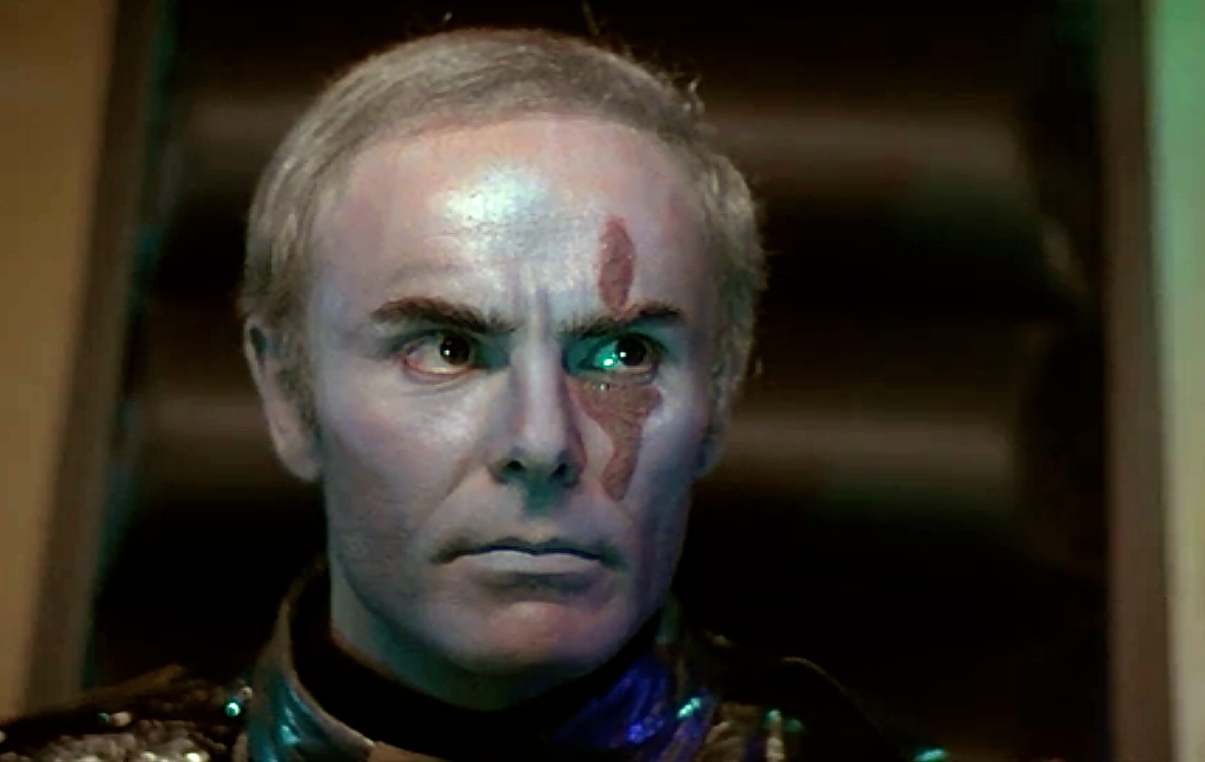 Saxon scowling.
Saxon scowling.
He does not drool nor scratch, but otherwise he has all the mannerisms of a major league Hollywood villain. He shouts at underlings, describes them as idiots, delights in torturing helpless victims, indulges his senses, devises impossible key performance indicators, cuts budgets, wait, he starting to sound like someone for whom I once worked.
A final confrontation between Saxon and Vaughn might have added up to something.
As it is, the crescendo, and I do mean crescendo because it is loud, of the movie is a twenty minute plus CGI shoot out that goes on and on, and on. (I did the crossword while the CGIs duked and nuked it out.) Peppard, Vaughn, and the Valkyrie, and finally Saxon get killed. At that point the film lost all interest for me, while the ever prepubescent John-Boy waxed on.
Did I mention the Valkyrie? No? What an omission!
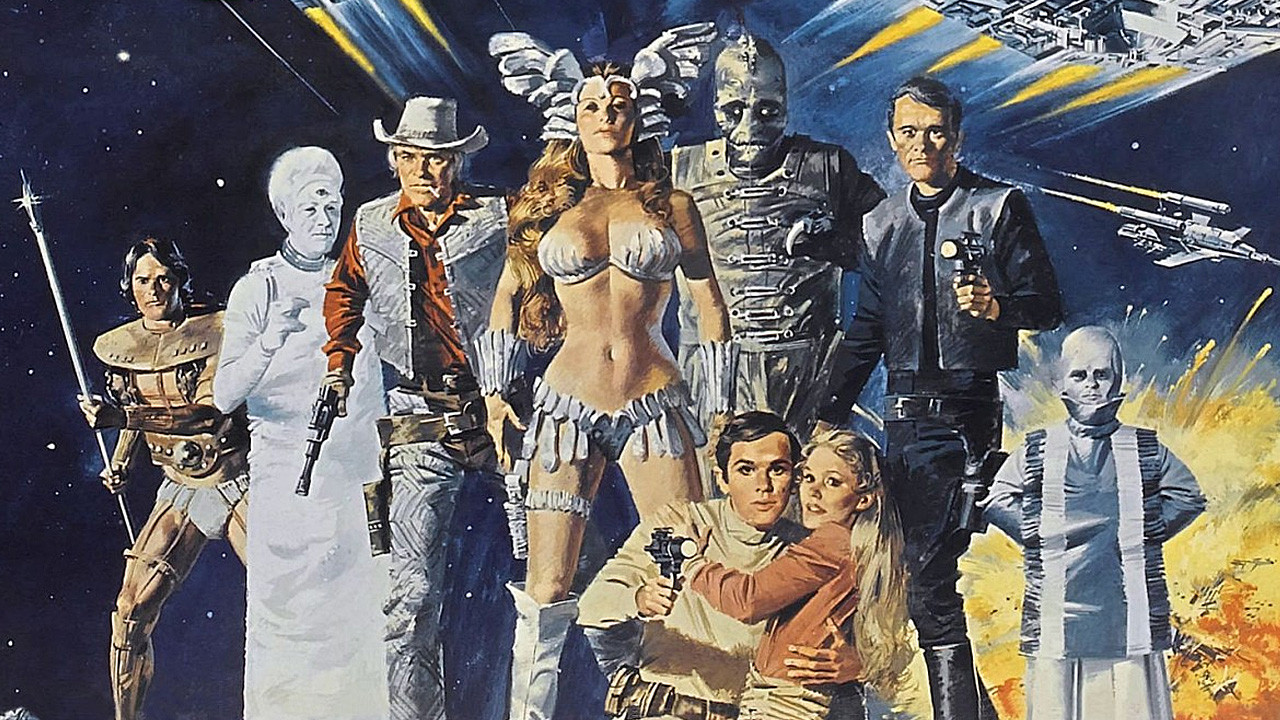 Spot the Valkyrie!
Spot the Valkyrie!
She has to be seen to be believed. Roger Corman can do some things right and she is one of them. Sybil Danning, need I say more, the queen of B-movie babes who started her career, I do not joke, with ‘The Long Swift Sword of Siegfried.’ Lucky Siegfried.
The mystery is how Roger Corman got such talents to work for him as Vaughn, Peppard, Saxon, and, this time let us not forget, Danning. These players are way above his usual payroll. John-Boy must have had some influence.
‘Dark Star’ (1974) and ‘Spaced Invaders’ (1990)
A pair of micro-budget parodies of big budget science fiction movies that offer more diversion than most of the films they mimic. Indeed while composing these bons mots I (tried) to watch ‘Saturn 3’ (1980) with Kirk Douglas and Harvey Keitel. It has a big cast, all that hair from Farrah Fawcett, and a big budget and set designs beyond the pale. It is pretentious and portentous. Now if it just had a story, a sense of humour, a purpose….something. I flicked away after twenty minutes. That the screen play was by Martin Amis probably explains all of that. (I tried reading one of his novels year ago, and it felt good when I stopped.) While enduring it I found a review from the doyen of reviewers, Roger Ebert, who mercilessly caned it. Amen, Brother Roger.
The ‘Space Invaders’ are the Z-team from a Martian armada bound for Alpha Centura. This hapless crew mis-read the map (upside down) and missed the fleet rendezvous (awoke too late) and is roaming around (lost in space) trying to catch- up, meanwhile exhausting the fuel. Think of those laggards with the Spanish Armada in 1588 who stormed ashore in Norway to… I was told once that the genetic inheritance from these dimwits explains both the swarthy genes and the stupidity of some Norwegians. It was Swede who passed the word on this.
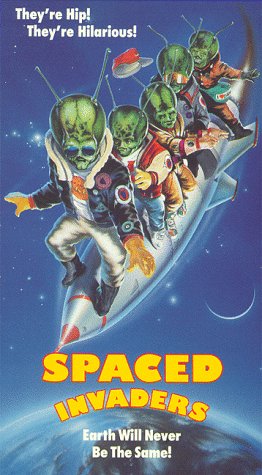
While tooling around in the flying saucer the spaced-out invaders intercept a broadcast of Orson Wells’s ‘War of the Worlds.’ It being Halloween a local radio station is airing an old recording for the occasion. These dolts from space lock on to that signal and land in…Hicksville Illinois, blasters drawn and ready for a fight. It is Halloween so one and all are decked out as the weird and wonderful; ergo they fit right in. What if the Martians invaded and no one noticed? They did. They didn’t. Just as well because a dolt forgot to charge the blasters.
Moreover, the townsfolk are in an expansive mood because an off-ramp from the I-80 has been built which will bring untold tourist wealth to this dying farm town when motorists fill one tank and empty another. (Think about it, Mortimer.) A few odd little guys in strange costumes are most welcome.
The cast of small town inhabitants is marvellous. The wannabe dumb blonde who cannot quite conceal her superior intelligence but irony is not something much noticed. The shy gas pump jockey pines for her but she’s out of his league so he studies advanced physics journals between horn honks for service from the town bullies. The jostling among the local magnates to take credit for the off-ramp goes on in costume. Then there is Royal Dano, instantly recognisable and whose memorable name is never remembered, as a cantankerous farmer who is about to lose his farm to a slimy small-time, small-town developer.
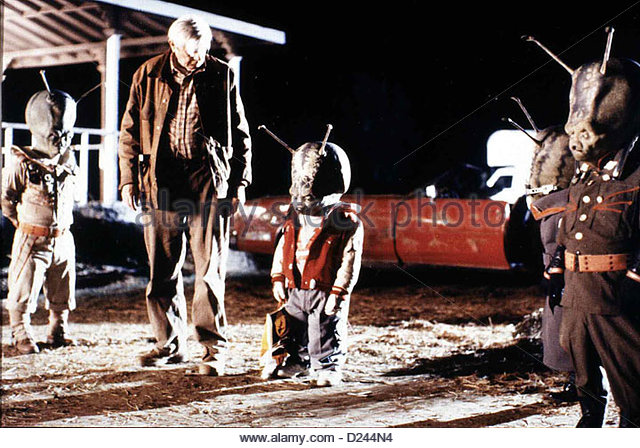 Dano in conference with the Xers.
Dano in conference with the Xers.
Vainly trying to keep order in this mix — the farmer has a shotgun or two and the developer has a bulldozer — is the lantern-jawed sheriff whose ten-year old daughter really likes the costumes of the Martians. Upon discovering they are not costumes, she says, ’They’re not bad. just stupid.’ Very.
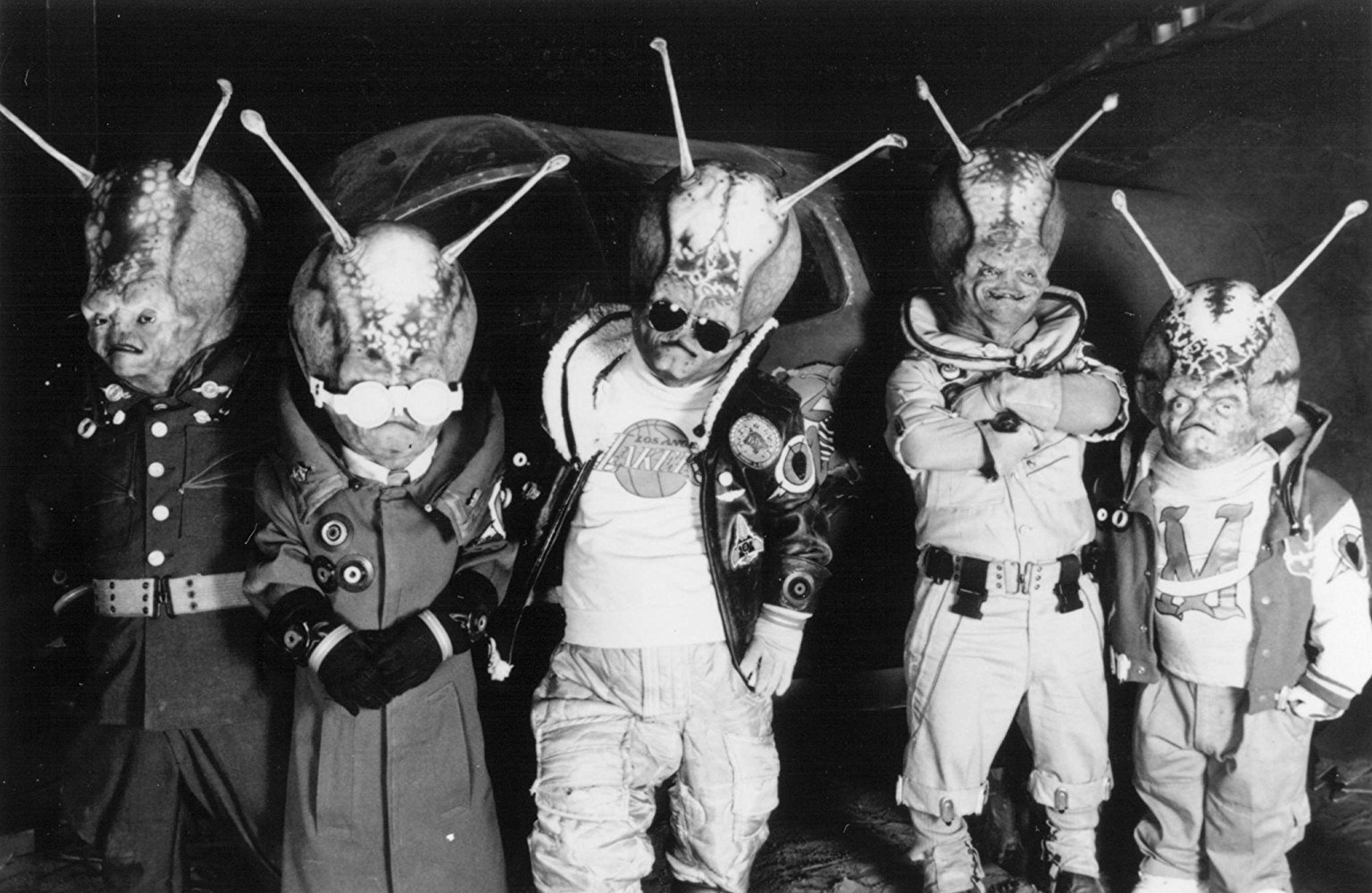 The Z-Team.
The Z-Team.
Delightful mayhem ensues. The off-ramp is offed. The developer loses his shirt and much else. The dizzy blonde figures it out. The gas pump jockey discovers the inner he-man. The angry farmer has the means to put things right. (Think silos.) With his help the Spaced Invaders might be able to catch-up with the Martian Amanda, or at least get to Norway and enrich the gene pool.
Segue.
‘Dark Star’ started as a student project by John Carpenter who went on to bigger but not always better things.
It is refreshing change of pace from so many portentous and pretentious A and B science fiction films about the meaning of life or the end of the world. Oh hum.
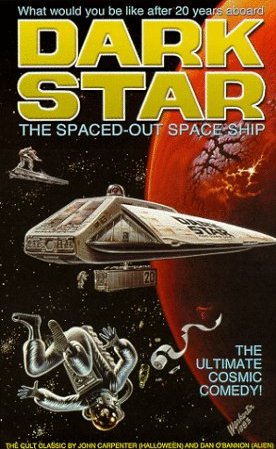
This entry is strictly working class. Five grunts who share a disheveled and no doubt odiferous dorm room on a space scow go about their business obliterating planets with smart, and talkative, bombs. They are galactic garbage men clearing up the detritus. That the planets may or may not be inhabited is of no interest to them. The planets are in the way of West-Connex and have to be demolished to create a space route. Sydneysiders know all about this mega road project which is consuming whole suburbs in its path. It is the local version of Boston’s Big Dig and has been in the offing even longer than that behemoth.
Cinephiles will think of the later ‘Quark’ (1977), but Quark was not working class. A garbage scow yes, but piloted by the well-spoken, highly educated, very clean, and aspirational Richard Benjamin who hopes for a promotion and a better assignment. None of that fits ‘Dark Star.’ This crew has topped out with Dark Star. Their career and life trajectories are down, not up.
On board Dark Star an industrial accident has killed the captain but head office demands that the remaining crew press on, though the faults on the ship multiply, even as their budget is cut and cut again. Situation normal.
To relieve some of the boredom one member of the crew has a pet. Which tickles. Even in elevator shafts. Has to be seen.
Meanwhile, systems on the ship malfunction, but appeals to head office for permission to put in for repairs are denied. Off camera I imagined the suits in the boardroom suppose the ship, Dark Star, is beyond repair and that these working stiffs are expendable. The crew members are contractors, so there will be no payout to beneficiaries. Managers managing.
Indeed most of the events can be explained from the McKinsey management manual, though it is well before the Age of Managers Managing. Shiver! That would make a slasher movie.
It all finally comes to a head …. There is a Silver Surfer at end. Intriguing that.
Apart from the gung-ho talking bombs, and the tickler, another high point is the sound track, most of it written and some of it performed by John Carpenter before he turned his hand to slasher movies with which he made a killing.
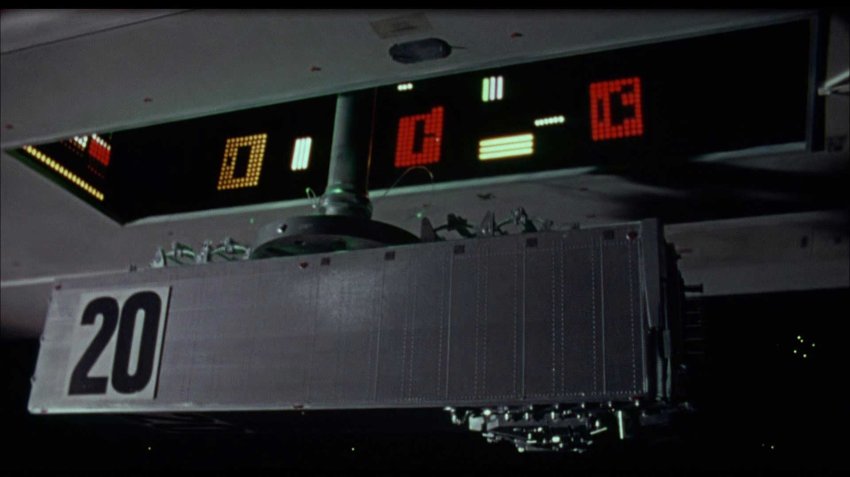 One of the smart (-mouthed) bombs.
One of the smart (-mouthed) bombs.
Roget Ebert liked it and that is all I needed to know.
‘The 27th Day’ (1957)
A low-key science fiction movie about, oh um, the end of the world. The set-up is interesting, but it limps in the middle and reaches a puzzling conclusion.
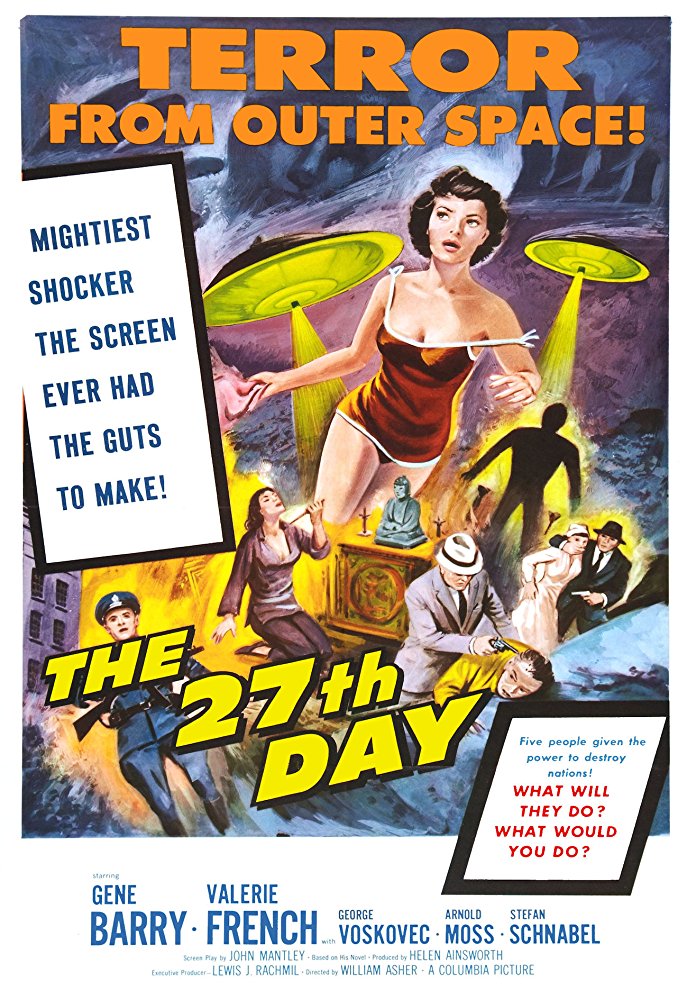 A misleading lobby poster. There are no zapping flying saucers chasing Valerie French in a bathing suit.
A misleading lobby poster. There are no zapping flying saucers chasing Valerie French in a bathing suit.
Gene Barry with his experience in outwitting Martians from the red planet at the height of the Cold War in ‘The War of the Worlds’ (1953) is here, sporting a RAF moustache that looks so fake that we knew it would have to go and it did. Arnold Moss as the alien is so effortlessly grave that … [on him more at the end].
Five individuals from around the world – Chinese, Russian, American, Brit, and Dutch – are plucked from their routine and plonked into plastic chairs in a bland conference room looking very modernistic though not modern. There is nothing special about them, one a villager, another a sentry, a press hack, a sunbather, and a scientist. With gender diversity the Chinese and the Brit are women. The Dutch scientist is in fact visiting the United States, so that gives Uncle Sam two.
After having proven to the gathering that they are on a spaceship, Arnold Moss presents the dilemma. His planet is doomed and the population must relocate. These are planetary asylum seekers. The Third Rock will do nicely, but being pacifists, they cannot conquer though it is evident that their technology is far superior. Even big Gort seems a clumsy relic against Moss’s magic.
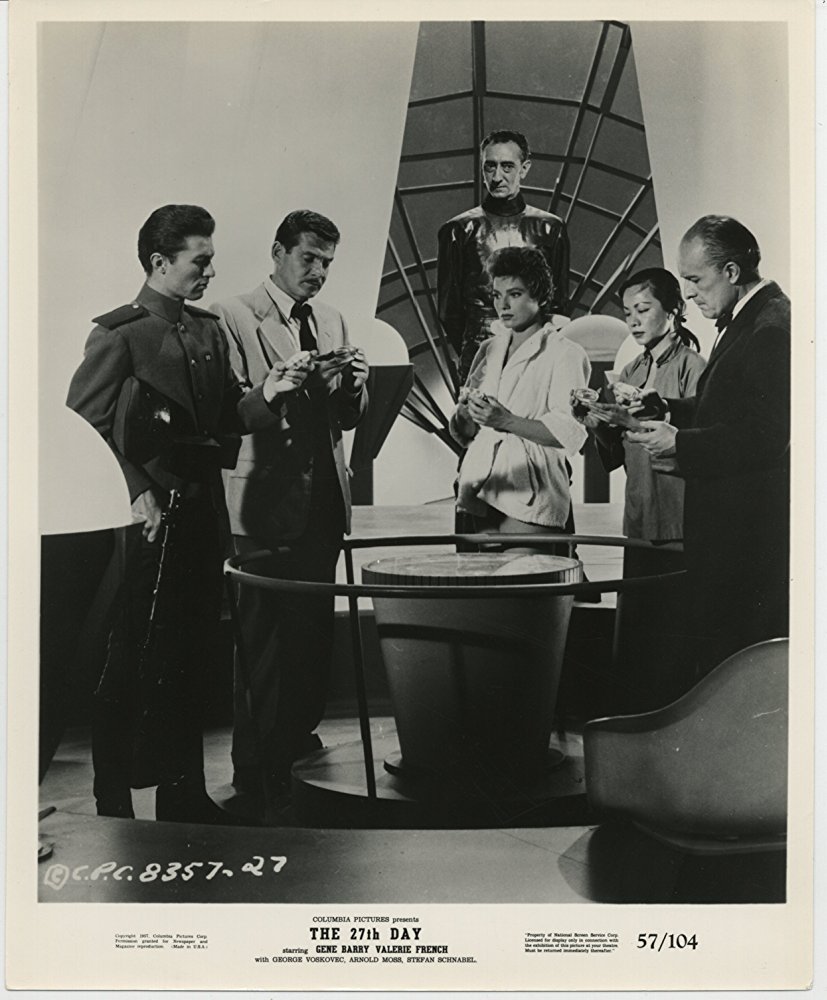 You have the power! (An early iPhone advertisement?)
You have the power! (An early iPhone advertisement?)
Apparently, neither can they negotiate. Instead Arnie will give each of the five a weapon (the size of an iPhone) that cam destroy their enemies. Note, it destroys only persons and not material. It works by thought control. If these weapons are not used by the end of the 27th day, the aliens will look elsewhere for suitable real estate and leave Earth alone, and the weapons will become useless. The explanation of the weapons is as detailed and as incomprehensible as McKinsey-speak but it covered every contingency the screenwriters could imagine, however, there is no manual for those who were not paying attention.
Knowing Earth history, it seems the aliens assume that some or all of the weapons will be used, and in effect that will depopulate the planet for their immigration. Rather like the Germans in the Franco-Prussian War stopping short of Paris, leaving the French there to murder each other and to save ammunition. Cynical. But then look at the news today.
During the briefing, Gene Barry gets the phone number of the English woman, clad in a bathing suit because she was plucked from the beach (hence the poster above), and then ‘Hey, presto!’ they are right back where they came from. She promptly throws her device into the sea, telephones Gene, and flies to LAX. She certainly has initiative and tenacity.
The Chinese woman, who says not a word and has no close-up, commits suicide. This seems to be in reaction to the massacre of her village which was underway when she was alien-napped. The cadre were practicing on the helots, they way they do.
The Soviet sentry is dumbfounded and keeps his mouth shut.
The Dutch scientist is on his way to a conference in New York City to which he now travels. Thus there are three possessors of this doomsday weapon and two of the devices are Stateside.
Sitting tight is not an option, because ….. Spoiler.
Because alien Arnold Moss goes on the air around the world on every radio and television channel in every language, he is more of media hog than the Twit in Chief. He tells everyone about the weapons and names the five who possess them. Cover blown! He had not told the five that he was going to rat them out like that!
The Feds latch onto the Dutchman as he lands at La Guardia.
Barry, having peeled off that moustache, thus disguised he grabs the Brit bit at LAX before the Forces of Order spot her, and together they head off to a hideout he just happens to know. (Probably cased it when dealing with those pesky Martians earlier.)
Pause for thought. Five randomly picked individuals have a doomsday weapon in their pockets. What will they do with them? That is one interesting proposition. Some will see parallels with the New Testament; I did.
Individual choice is quickly compromised by the public broadcast of their names. The Soviet grunt is arrested, suborned, tortured, but remains silent for a time. His motivation is left a blank. In the end, rather than see the weapon used he commits suicide by throwing himself out of an upper story window.
Barry and his girl puzzle over what to do in their hideout. The Dutchman, like the Soviet, keeps the secret…for a time. Though he is pressured relentlessly by the CIA operatives, but none of his inquisitors brought a waterboard.
The second interesting proposition concerns how others react. That an alien is at work becomes accepted by authorities and the public at large. The five individuals are then seen in the ensuing panic to be agents of the alien with Rush Limbaugh-like hysteria laid on. Imagine that! A man bearing a resemblance to Barry, remember that mo, is murdered by a mob. Add Faux News to that equation and the lynchings would be general.
Barry’s idea is to sit out the twenty-seven days, and by some miracle he and his squeeze seem to have enough provisions in the two bottomless grocery store paper bags they have to survive for the duration (of the film) undetected. Until….
Yes, the Soviet grunt finally cracks and the weapon is now available to the USSR, which promptly proclaims it to blackmail the USA to pull out of Europe and Asia. Uncle Sam complies.
This turn of events brings patriot Barry and Valerie out of hiding in the hour of need. The Western Alliance of the American Barry, the Brit bit, an the Dutch professor stall but time is running out. The Russkies know that the weapon will lapse at the end the twenty-seventh day so if it is to be used then it must be before then. To prevent a retaliation from the weapon(s) in the USA, the best time to use is just before expiration. The Cold War context weighs heavily throughout.
Meanwhile, Barry and company test the iPhone weapon app and it does indeed work. Ergo the compliance noted above.
But the professor has a trick or two up his academic gown. When Moss handed over the devices he said it has ‘the power of life and death.’ Significant that? He did not say ‘life or death.’ This egghead applies himself to re-programming the devices with his big brain so as to kill only ‘the enemies of freedom.’ Wow!
We all have candidates for that hit list. Think of whom Ayn Rand would put on that list. Try not to think of Rush Limbaugh. Try harder!
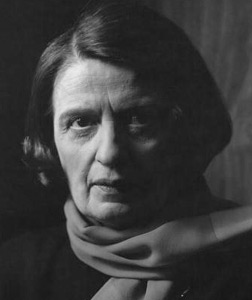 Ayn Rand
Ayn Rand
As the clock ticks and the Soviets prepare to activate the weapon app, the professor does his stuff and … that is it. ‘The enemies of freedom’ die! How easy was that! Lots of Russkies pile up in the streets.
In the aftermath at the United Nations there is an expansive spirit of unity of those who made the cut and Barry suggests offering the aliens some help. Maybe they could inhabit the parts of the Earth that are uninhabitable. The Antarctic is mentioned. New Jersey near the Kardashians seems logical? Some nice real estate in the Gobi Desert can be had for a price. This message is broadcast, and on the eighth ring Arnold Moss answers and rather than accept the offer instead welcomes the Earth into the community of 30,000 worlds! Whoa!
Huh? Was this some kind of fraternity initiation? That seemed to be the conclusion invited by Moss’s last remarks. Such a test for admission is a common theme in sci-fi but here it is explained no further.
The film drags in the middle with Barry and the Brit in the hideout listening to the radio. The minutes seemed like hours to them and to me, too. The whole exercise would have been much better in a half-hour Twilight Zone or Science Fiction Theatre episode.
A few notes. Two suicides. The voluntary production code that dominated Hollywood at the time forbade suicides in word or deed. Yet there are two here. The Chinese woman early on and the Soviet soldier near the end. Perhaps because they were both commies, they were better dead than red.
Both the women endowed with the weapon reject it. The Chinese throws it on the fire burning the remains of the village before committing Chinese-kari and the Brit throws it into the sea before flying to Hollywood, well, LA. Lesson? Never trust a woman with a weapon of mass destruction.
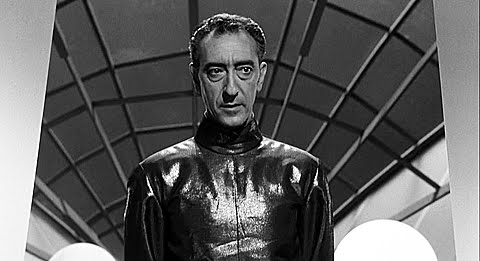 Arnold Moss (1910-1989)
Arnold Moss (1910-1989)
Moss appeared in ‘The Conscience of the King’ in ‘Star Trek: TOS’ as Karidian the executioner. With his aristocratic bearing, perfect diction, and melliferous baritone voice he always dominated any scene. Something (else) William Shatner complained about. Moss was Phi Beta Kappa with a Columbia PhD who constructed crossword puzzles for the ‘New York Times’ while waiting on sets.
‘The Creation of the Humanoids’ (1962) at 1hr 15 min
This film rates a miserable and miserly 5.9 from 660 votes on the IMDB. That puts in the company of some Roger Corman’s creations. Democracy, so overrated, as Plato said.
This is a thoughtful science fiction film about racism and bigotry in a post-apocalyptic world. It starts with 92% mortality in a nuclear war, the origin of which is unknown, after which the survivors have created ever more elaborate and human-like robots. The robots are programmed to serve the best interest of humanity! Always tricky that, just ask anyone in politics. (Only journalists know all the answers.)
 A lobby poster
A lobby poster
The robots are necessary but they have to stay in their place! Evidently some Republicans survived — no holocaust is ever perfect — and those who most want to restrict the robots are members of the Order of Flesh and Blood, i.e., code for the GOP. Indeedy. These Luddites accept the work the robots do so long as they look and act like mechanical contrivances and stay in their distant and inferior place. Jack Haley as the Tin Man in ‘The Wizard of Oz’ is their idea of a good robot.
However, the robots themselves realise that such Tin Men are inefficient. They are technically inefficient, clumsy of movement, slow afoot, so they improve themselves with each new iteration. (The make-up is good on this.) The more important way in which they are inefficient is that there are social and psychological barriers between them and human co-workers. Some humans refuse to work with these talking machines.
The robots face the facts: the long term effects of the massive radiation unleashed in the forty minute war has doomed the capacity for human reproduction. The birth rate is falling at an increasing rate.
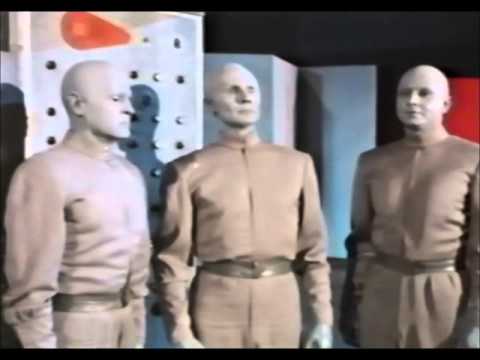 The robots confer on their Key Performance Indicators.
The robots confer on their Key Performance Indicators.
For the Flesh and Blooders the answer is simple, ahem, as always, to get rid of those damn robots. Period. Their service makes us soft! Rid of them, humanity would fend for itself and grow stronger again, scientific evidence be damned! Ayn Rand should get credit for this part of the script. In her world the will power of rugged individuals could triumph over any old facts.
The Flesh and Blooders wear party hats and harass those who support and use robots. (On the hats, read below.) They skulk around robot recharging stations. Among themselves, the robots call the charging stations temples and refer to the master computer with admirable and anticipatory political correctness as the Mother/Father or Father/Mother. As it turns out, there is a point to this mumbo-jumbo.
Humanity is dying out and the robots will have to put a stop to it. And they do!
The drama is played out with two principle characters (Don Megowan and Erica Elliott). The irony is that the Luddite leader, vociferous and violent, is himself an undercover humanoid! But wait there’s more. His squeeze is also one of THEM! The explanation of all of that is ingenious and thought-provoking.
It is all talk and no action against cardboard sets spray painted in primary colours. It seemed more like a play than a movie, but the talk is interesting and I paid attention. A rarity that. That there is no action, that the women are fully clothed, and that it is complicated talk must together explain the democratic rating. The Maestro of ‘Dark Corners of this Sick World’ Robin Bales, no democrat he, also shreds it for the inertia and the inconsistencies in the story, while admitting that it is full of ideas. The alleged inconsistency is that it starts out about the downtrodden robots and then shifts to the future of humanity. Get with it Robin! It is a segue. Stories develop.
By the way, he, too. suspected theatrical origins but evidently found no confirmation, an inference since he left the point hanging. Just the sort of omission he derides in the films he reviews with his razor tongue.
Don Megowan, large of size, chiselled of chin, deep of voice, dark of hair, was a stalwart in television westerns for years, while Erica Elliot quit with this role, she also started with it, as did the director Don Doolittle whose coda was a nice touch.
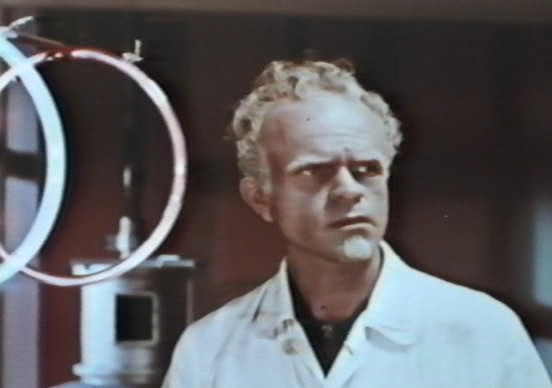 Dr Doolittle, who talked to the vacuum tubes.
Dr Doolittle, who talked to the vacuum tubes.
The opening credits say ‘Introducing Don Doolittle’ and the Internet Movie Data Base indicates this introduction was also his finale.
The hats the Flesh and Blooders wear are ersatz Confederate forage hats. They were sold as novelties at the centenary of the Civil War. Yes, I had one.
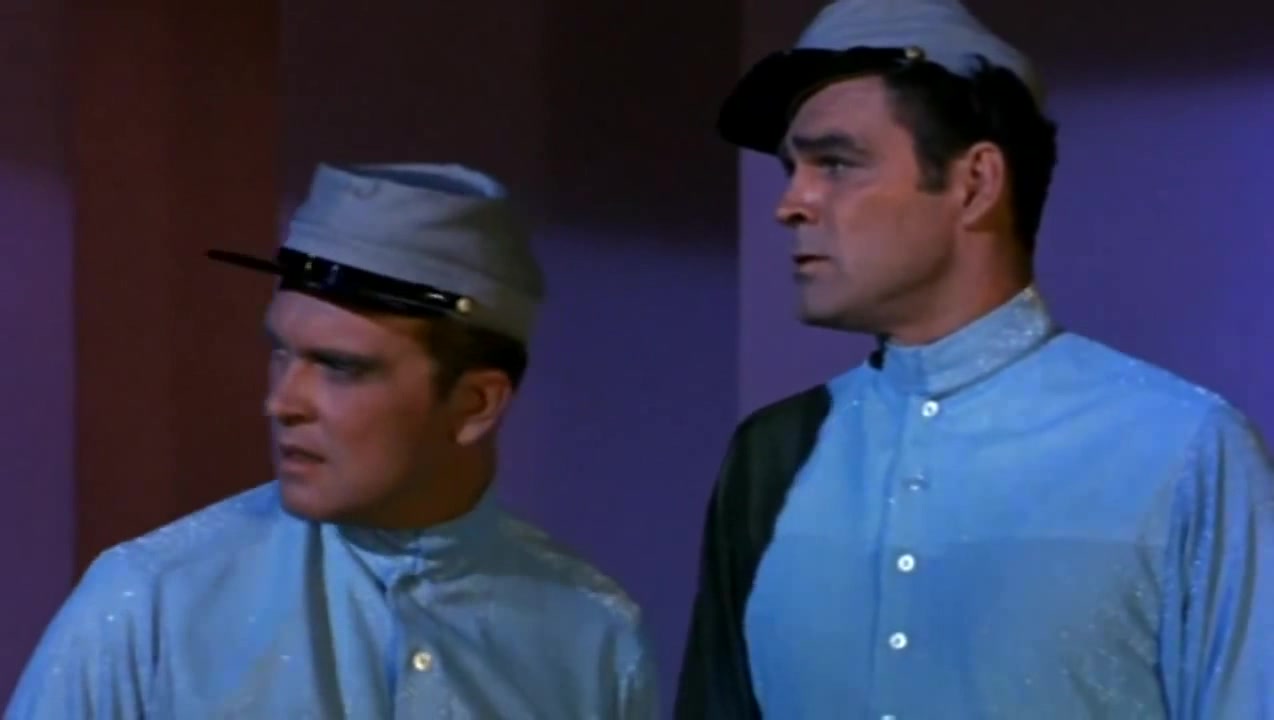 Big Don is the big one.
Big Don is the big one.
Did they purloin those hats from the dustbins after a revival of ‘Gone with the Wind?’ Who knows. It is all of a piece with the hundred dollar budget for the film.
I came across it on You Tube when trawling for 1940s, 1950s, and 1960s science fiction.
It has whet my appetite for ‘Real Humans’ (2012), a Swedish series aired here, which for reasons lost to time, we did not watch.
Jaded cinephiles will think of Isaac Asimov’e ‘I, Robot’ and ‘Blade Runner.’ Readers may recall ‘Tin Men’ (1965) by Michael Frayn, which tried awfully hard to be funny.
‘Ride the High Country’ (1962)
One of the great westerns. It combines a young director with two of the wisest hands on the ranch. Randolph Scott and Joel McCrea between them must have been in more than a hundred and fifty oaters. McCrea made it a point only to accept roles in Westerns and Scott did virtually the same thing though less explicitly. I would like to think that they did so for the same reasons that Justin Playfair gives in ‘They Might be Giants’ for only watching western movies. See the review of this latter film elsewhere on this blog for further explanation.
 A publicity photograph.
A publicity photograph.
Two ageing lawmen find the west has changed and so have they. It is no longer in need of them. One has become a sideshow barker and the other a bar-room bouncer. Then a job comes up, one with a modest reward but it smacks of the old days and the old ways, off they go once again a team. One is losing his sight and other has arthritis but this is too good an opportunity to miss….for one of them it offers vindication and for the other one it offers something more venal.
In 1962 audiences were also changing and the Western was on the way out. Nor was there any further need in Hollywood for these two old actors in particular. The screenplay reflects their own situation, too. It becomes a story about the actors as well as the characters they embody.
The tattered McCrea remains steadfast, but the flamboyant Scott has heard a different drum, after countless brawls, wounds, ambushes, shoot outs, injuries, chases, beatings, falls, and betrayals it is time to taste the honey. With what he thinks is subtlety Scott tries to suborn McCrea who seems not to realise what is going on. Subplots add depth and as in every Peckinpah film, each character however minor has a name. Edgar Buchanan’s brief speech at the wedding, Federico Fellini could not have done better, gave me pause for thought.
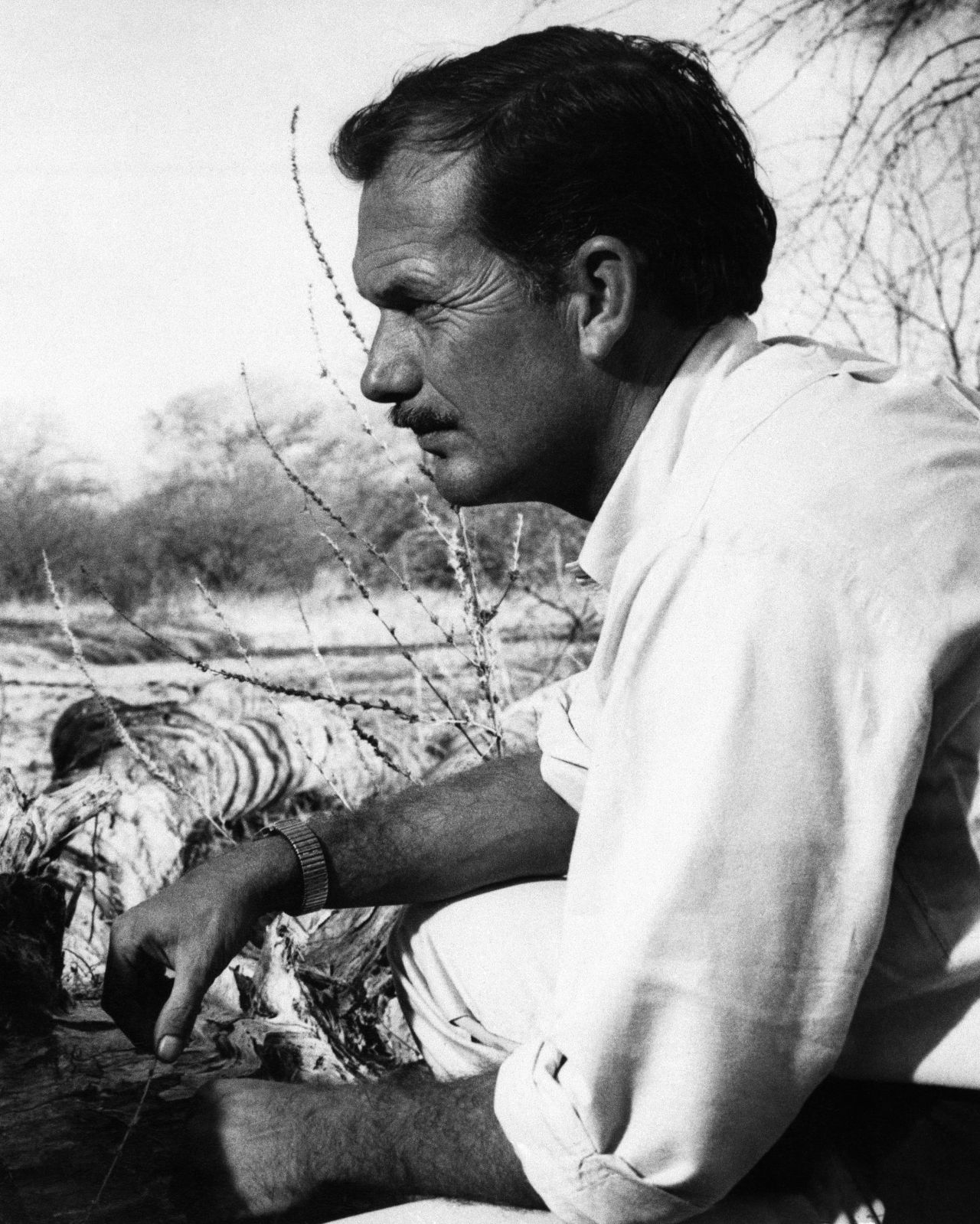 Sam Peckinpah
Sam Peckinpah
The Biblical reference to ‘entering the house justified’ is another gem.* Any close observer of Peckinpah’s films will realise, he was student of the Bible and studded his films with imagery and lines from parables, hymns, letters, psalms, and words of the prophets.
The landscape of the high country is an elegy to a cleaner, better world made foul by humanity at its worst.

Then the denouement comes. Perfect. The exchange of looks between McCrea and Scott constitute a master class in acting in a few seconds. Each man sums up his own celluloid career in a single glance.
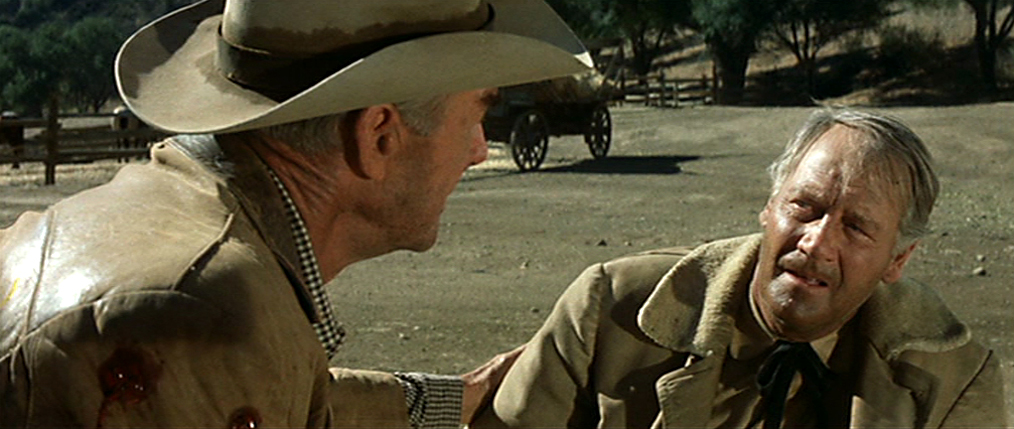 The end.
The end.
Then there is that last line of dialogue delivered by McCrea as his sun sets. Moving and marvellous. Redemption is even sweeter than honey.
*Luke, 18:14
‘The Night People’ (1954)
A very cold Cold War film noir set in the Berlin of 1953, just after the Korean War. Everyone is on edge. The military presence — USA, Great Britain, Soviet Union, and France — in Berlin is considerable. Is there going to be a European encore for the Korean War there in Berlin?
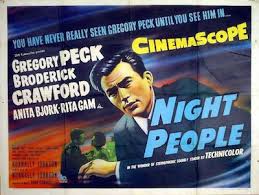
Gregory Peck is in US counter-intelligence, trying to extract a Soviet defector when he is lumbered with the kidnapping of an American soldier, a private, with a very influential and noisy father, played to a T by Broderick Crawford. It is taken as obvious that the Soviets have nabbed the son, but why?
Crawford flies to Berlin to show the paper-pushing bureaucrats how to get results in the real world! This he tells to newsmen whose circumspect replies tip off viewers to what will follow.
In this Berlin human beings are trafficked in all kinds of ways and this incident is another example of that. Nothing happens by chance. Everything connects, somehow, but how?
Crawford discovers a world where insistent bluster and big bucks do not matter one whit. No one wants his money and his bellows fall on deaf ears. Peck gives him a marvelous dressing down but Peter van Eyck does even better in an earlier and lower key scene in breaking the news that his big money and many friends mean nothing in this time and place.
Before he became Jed Clampett, Buddy Ebsen is a perfect chorus to Peck who is effortlessly glamorous and briskly decisive, while Ebsen is an ‘ah shucks a good ole boy,’ but one who knows how to get things done even in this dark and menacing place.

Much of the screen play is cryptic by today’s standards. It takes awhile to realise that the extraction is afoot, and the importance of that briefcase Peck constantly carries around slowly dawns. He carries it around, I inferred, because in it he has the most top secret confidential documents that he does not trust, even to a safe at HQ. It is always in his hand or always in his sight. Almost.
Since he is there, Peck insists that Crawford witness the proceedings. He does and it is an eye-opener for him, and a growth experience, though Crawford’s change of heart is a little too quick but the clock ticks relentlessly in this film, and if the final result is just a little too easy, it does wrap everything up with a mighty twist.
There is a lot of talk and virtually no action. In Hollywood terms that makes it cerebral and it would probably not be made today in this way. Most of it occurs in offices or rooms, with one scene in a bar and another at the loading dock of a hospital. One punch is thrown when Peck strikes a woman!
Nunnally Johnson (1897-1977) wrote the screenplay and it is a corker for its overall plot, its humanity, and dialogue.
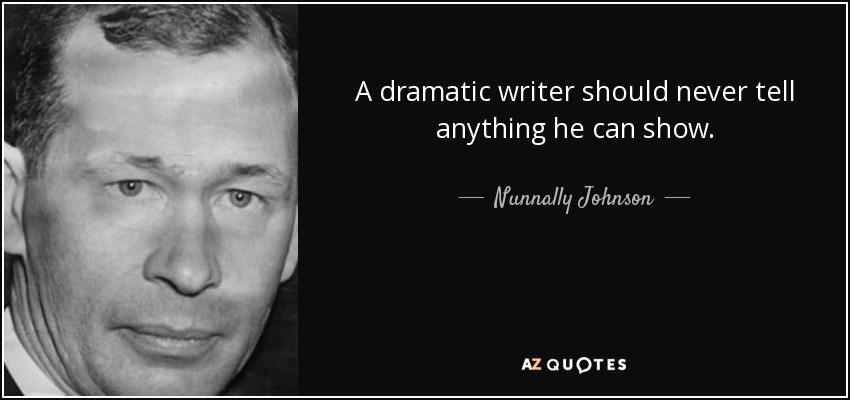 If only…..
If only…..
Among his many other credits are ‘Grapes of Wrath’ (1939), ‘Tobacco Road’ (1941), ’The Moon is Down’ (1943), ‘How to Marry a Millionaire’ (1953), and ‘The Man in the Gray Flannel Suit’ (1956). The themes in these films include that depression, corruption, oppression, anti-semitism, and racism, and then there is the delightful comedy of ‘How to Marry a Millionaire.’
The military parade at the beginning does drag on but to original audiences in 1954 it would have been reassuring, and it segues nicely into the plot. Original audiences would also have seen that both Peck and Ebsen wear uniforms with shoulder patches indicating combat service in World War II and both uniforms sport impressive ribbons betokening Silver and Bronze Stars. They have been in the shooting war.
I watched it on a DVD acquired from Amazon.
‘The Stalking Moon’ (1968)
One of the many Westerns that Gregory Peck (1916–2003) made. That alone recommends it. The opening scene is superb and those that follow in the first act are on a par with it. Then comes the slide….
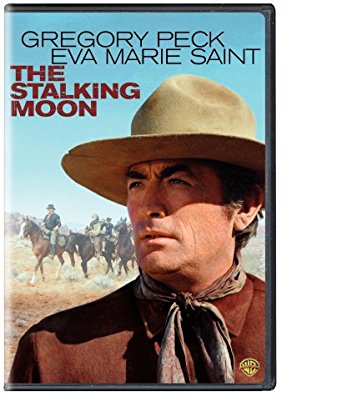
The silence, the eternal and forbidding landscape, the big sky, and the taciturn dialogue get it off to a good start.
Robert Forster steals some scenes from his mentor Peck, but ever gracious Peck rolls with it. Forster has since been in every television program there is but never equalled this turn.
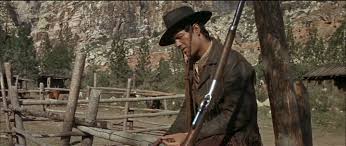 Robert Foster waits.
Robert Foster waits.
There are some moments of humour as with the train ticket that it would take an IRS accountant to figure out.
Harder to take is that chiseled block of satin wood, Eva Marie Saint. That she is largely silent helps but the constant squeeze of the frontal lobes indicates her thespian range. When she speaks it is in whispers which I suppose is to add to the drama. It didn’t. (I admit that she was superb in ‘Don’t Come Knocking’ [2005] with Sam Shepard. Maybe with age directors were less inclined to limit her to eye-candy.)
Most of the faults of this film, however, lie with the screenplay and the director, Robert Mulligan (he of ‘To Kill a Mockingbird’), and not the players. Where to start?
Eva, after ten years of (implied) brutal captivity, emerges with makeup intact and speaks English within five minutes as though nothing had happened. It is a strength of the screenplay that what happened is left to the viewers imagination and not stated, agreed. Yet she is none the worse for it.
Peck’s change of heart is a plot device and nothing more. It does not emerge from the events or his character. He says she can cook for him and Ned, but in the only scene of cooking, Ned, does not eat with them. Ned, too, is a plot device and meets the fate of a Star Trek Red Shirt in due course. That was obvious from his first appearance.
The aggrieved indian husband come to fetch home his son is granted no humanity. He is a spectre. Yet Peck has stolen his son as well as his wife. Why Peck chose to invite his wrath remains a mystery. This indian is supposed to be preternatural, yet when the showdown comes he is very visible and it must have taken practice to miss him with fusillade of rifle shots fired at him. He on the other hand drills Forester with one shot.
For a spectre he was none too bright. He lured the two younger men away but did not then go back to fetch his boy, who would have willingly come to him. Instead he prolongs the movie another twenty minutes. So that he can do the same thing again. In a Randolph Scott movie, made on a smaller budget, this kind of repetition did not exist.
But then Peck seems to lack smarts, too. In the last confrontation the indian is backlit in a doorway and Peck has a cocked rifle in hand, but waits politely for nemesis to enter the darkened room and shut the door so that they can slug it out in the dark. Go figure that one, Mortimer. Shouting at Peck to shoot, did not work. Indeed many of the interiors are too dark to see much.
Indeed the boy is likewise not granted humanity. He is a prop for Eva. That he might have collaborated with his father at the moment of truth seemed on the cards (joke, but to get it see the movie) but was forgotten come the time.
While decrying plot devices there is the dog. It is not present until needed for one scene, then is conjured as the watchdog. Ned’s reaction as that of a hardbitten frontiersman is a scriptwriter’s cliché.
The final contest between the two alpha males is a forgone conclusion. If that is all that was at stake, we all knew how that would end, and we did not need 1 hour and 59 minutes to get there.
I watched it on Daily Motion and read Roger Ebert’s contemporary review. He nailed it. But then when did he not?
